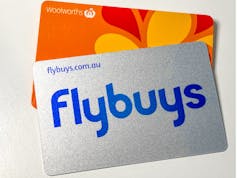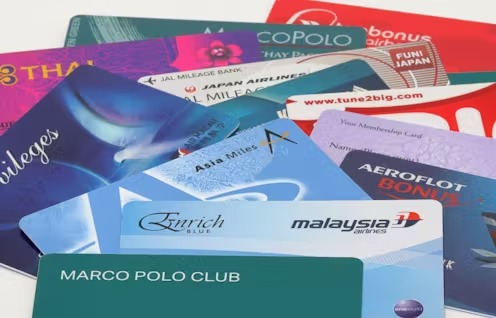Loyalty programs enable firms to offer significantly lower prices to some of their customers. You’d think this would encourage strong competition.
But that isn’t always what actually happens. New research shows that paradoxically, by changing the way companies target customers, loyalty programs can sometimes reduce price competition. The research also points to solutions.
A win-win proposition?
Joining a loyalty program is supposed to be a win-win. You – the customer – get to enjoy perks and discounts, while the company gains useful commercial insights and builds brand allegiance.
For example, a hotel chain loyalty program might reward travellers for frequent stays, with points redeemable for future bookings, upgrades or other benefits. The hotel chain, in turn, records and analyses how you spend money and encourages you to stay with them again.

Australia’s two major supermarkets have well-established loyalty programs. GiselleA/Shutterstock
Such programs are commonplace across many industries – appearing everywhere from travel and accommodation to supermarket or petrol retailing. But they are increasingly coming under scrutiny.
In 2019, the Australian Competition and Consumer Commission (ACCC) cautioned consumers about the sheer volume of personal data collected when participating in a loyalty program, and what companies can do with it.
Hidden costs – such as having to pay a redemption fee on rewards or losing benefits when points expire – are another way these schemes can harm consumers.
But a larger question – how loyalty programs impact consumers overall – remains difficult to settle, because their effect on competitiveness is unclear. As the ACCC’s final report notes, on the one hand:
Loyalty schemes can have pro-competitive effects and intensify competition between rivals leading to competing loyalty discounts and lower prices for consumers.
But on the other hand:
Loyalty schemes can also reduce the flexibility of consumers’ buying patterns and responsiveness to competing offers, which may reduce competition.
How a two-speed price system can hurt everyone
A new economic theory research working paper, coauthored by one of us (Kominers), suggests that on competitive grounds alone, loyalty programs can sometimes harm all consumers – both ordinary shoppers and the program’s own members.

Membership systems allow retailers to charge non-members a less competitive base price, earning a higher margin. ZikG/Shutterstock
It’s easy to see how the ordinary shopper can be worse off. Since a firm’s loyalty program enables it to offer discounted prices to its members, the firm can raise the base prices it offers to everyone else. Those not participating in the program pay more than they otherwise would have, and the firm can respond by saying “join our program!” instead of having to lower its price.
But sometimes, even the program’s own members can end up worse off.
When a given customer’s loyalty status is not visible to a firm’s competitors – as is the case in many loyalty programs today – it’s hard for those competitors to identify them and entice them to switch.
The main way to compete for those customers becomes to lower the base price for everyone, but this means missing out on the high base margins achieved through the existence of your own loyalty program – remember, having a loyalty program means you can charge non-members more.
It’s often more profitable for firms to just maintain high base prices. This, in turn, reduces overall price competition for loyal customers, so firms can raise prices for them, too.
What’s the solution?
Despite these effects on competition, loyalty programs still offer benefits for consumers and an opportunity for brands to form closer relationships with them.
So, how do we preserve these benefits while enabling price competition? The research suggests an answer: making a customer’s loyalty status verifiable, transparent and portable across firms. This would make it possible for firms to tailor offers for their competitors’ loyal customers.
This is already happening in the market for retail electricity. While there aren’t loyalty programs there per se, a consumer’s energy consumption profile, which could be used by a competitor to calibrate a personalised offer, is known only to their current electricity supplier.
To address this, in 2015, the Victorian government launched a program encouraging households to compare energy offers. This process involved first revealing a customer’s energy consumption profile to the market, and then asking retailers to compete via personalised offers.
By opening information that might have otherwise been hidden to the broader market, this approach enabled firms to compete for each other’s top customers, in a way that could be emulated for loyalty programs.

Some airlines offer ‘status match’ policies which allows customers to move between competitors’ loyalty programs while maintaining their status level. Skycolors/Shutterstock
Such systems in the private sector could build upon “status match” policies at airlines. These allow direct transfer of loyalty status, but currently rely on a lengthy, individual-level verification process.
For example, a design paradigm known as “Web3” – where customer transactions and loyalty statuses are recorded on public, shared blockchain ledgers – offers a way to make loyalty transparent across the market.
This would enable an enhanced, decentralised version of status match: a firm could use blockchain records to verifiably identify who its competitors’ loyal customers are, and directly incentivise them to switch.
Both startups and established firms have experimented with building such systems.
What next?
New academic research helps us model and better understand when loyalty programs could be weakening supply side competition and undermining consumer welfare.
A neat universal solution may prove elusive. But targeted government or industry interventions – centred on increasing the transparency of a customer’s loyalty status and letting them move it between firms – could help level the playing field between firms and consumers.



 Vivendi Reveals Assessment to Split the Company is Ongoing
Vivendi Reveals Assessment to Split the Company is Ongoing  Samsung's Lee Jae-Yong Forges Strategic AI Chip Production Alliance With ZEISS
Samsung's Lee Jae-Yong Forges Strategic AI Chip Production Alliance With ZEISS  Court Documents Unveil $1 Billion Annual Revenue of Shell's Oil Trading Business in US
Court Documents Unveil $1 Billion Annual Revenue of Shell's Oil Trading Business in US  Deutsche Bank Considers Settlement in Postbank Takeover Litigation
Deutsche Bank Considers Settlement in Postbank Takeover Litigation  DeepL Unleashes AI-Powered Tool for Business Writing
DeepL Unleashes AI-Powered Tool for Business Writing  Mainland China Investors Blocked from Accessing New Hong Kong Bitcoin ETFs
Mainland China Investors Blocked from Accessing New Hong Kong Bitcoin ETFs  KT Innovates Media, Content Business Through AI
KT Innovates Media, Content Business Through AI  BTS Agency Hybe Demands Board Meeting, Ador CEO Rejects ‘Illegal’ Request
BTS Agency Hybe Demands Board Meeting, Ador CEO Rejects ‘Illegal’ Request  Tesla Cybertruck Spotted in Sydney Sparks Debate: Potential Australian Release?
Tesla Cybertruck Spotted in Sydney Sparks Debate: Potential Australian Release?  Tesla Debuts Enhanced Autopilot in China for Just $98 Monthly
Tesla Debuts Enhanced Autopilot in China for Just $98 Monthly  Star Entertainment’ David Foster Quits Just Weeks After Appointment
Star Entertainment’ David Foster Quits Just Weeks After Appointment  Musk Engages China: Baidu’s Data Deal and High-Stakes Hotel Meet with CATL
Musk Engages China: Baidu’s Data Deal and High-Stakes Hotel Meet with CATL  Philip Morris International Eyes Heated Tobacco Market Expansion in the US
Philip Morris International Eyes Heated Tobacco Market Expansion in the US  McDonald's Korea Launches 'Mom's Bed' Campaign Highlighting Caregiver Hardships
McDonald's Korea Launches 'Mom's Bed' Campaign Highlighting Caregiver Hardships  DJI Faces Possible US Ban by Congress, Echoing Concerns Over TikTok and China
DJI Faces Possible US Ban by Congress, Echoing Concerns Over TikTok and China  McDonald's Korea Announces Price Hike Amid Record Revenue
McDonald's Korea Announces Price Hike Amid Record Revenue  Adidas and Stepn Unveil NFT Sneakers in Trailblazing Web3 Partnership
Adidas and Stepn Unveil NFT Sneakers in Trailblazing Web3 Partnership 

































